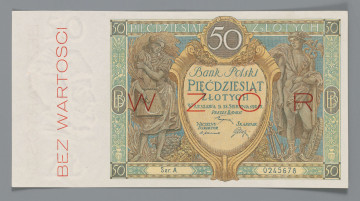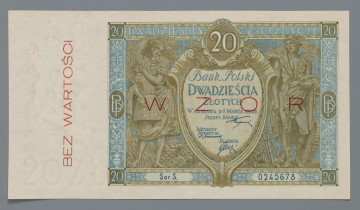
Cheque for 50,000,000 Polish marks - a template
1923
National Museum in Lublin
Part of the collection: Paper money during the Second Polish Republic
The interwar period was a time of great achievements, but also of problems with which the reborn Polish state had to contend. Among them was the painful period of the so-called Great Depression, which began in October 1929. Poland was one of the countries in which it lasted the longest – until 1933. During this period, banknotes of various issues circulated in Poland. For example, from the beginning of the economic collapse on Black Thursday, 24 October until the end of 1929, Polish citizens used substitute money in the form of five-zloty state tickets and banknotes in the denominations of 10, 20, 50, 100 and 500 zlotys, The 20-zloty banknotes were available in two variants (the 1919 and 1926 issues were introduced into circulation in 1924 and 1927 respectively), and the 50-zloty banknotes in three variants (the 1919, 1925 and 1929 issues were introduced into circulation in 1924, 1927 and 1929). The diversity of variants was not reduced by the withdrawal of some of the oldest denominations, as they were replaced by new issues which did not have a uniform graphic design, and even did not show any special stylistic similarities. In such circumstances, on 20 June 1931, it was decided to introduce a new 20-zloty banknote. It was the fourth variant of this denomination within the last seven years. The banknote was designed by the graphic artist Ryszard Kleczewski, who worked at the Polish Security Printing Works, and the woodcut used for printing was Professor Eugène Gaspé’s work.
The right side of the obverse features the figure of Emilia Plater, while the reverse shows an allegory of the Polish economy. The central field features the frontal figure of an adult woman holding a sheaf of grain, accompanied by two small boys. One of them is holding a huge hammer in his hands, while the other is holding a model of a ship. On the periphery there are two other little boys with attributes in the form of a sheaf and an anchor. It is not surprising that the role of agriculture was emphasised, given that it was the basis of the Polish economy at that time. However, the artist was also particularly interested in showing the role of the shipbuilding industry. It is linked to the interest in maritime affairs in the interwar period, which was evident in the policy of the state and the attitude of Polish society.
Leszek Poniewozik
Author / creator
Dimensions
cały obiekt: height: 164 mm, width: 87 mm
Object type
paper money
Technique
Material
paper
Creation time / dating
Creation / finding place
Owner
The National Museum in Lublin
Identification number
Location / status

1923
National Museum in Lublin

1925
National Museum in Lublin

1926
National Museum in Lublin
DISCOVER this TOPIC
Museum of King Jan III's Palace at Wilanów
DISCOVER this PATH
Educational path